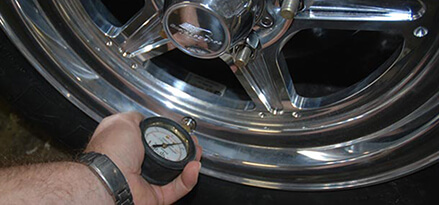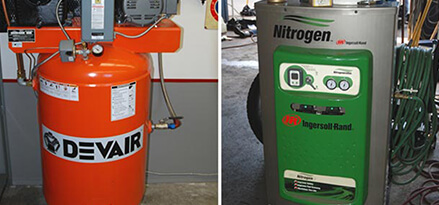By Wayne Scraba, automedia.com
Today, you'll notice green nitrogen "filling stations" at tire shops across the continent. Typically, filling a tire with nitrogen costs in the range of $10 per tire (although a few shops include it for free when they sell you a new set of tires). Using compressed nitrogen instead of compressed air isn’t really new. The military, commercial airplanes, race cars and even space shuttles have used it for years.
So far so good, but what’s the difference between air and nitrogen in tires? The atmosphere of the Earth is composed primarily of nitrogen (78 percent); the remaining balance is oxygen (21 percent) mixed with a small percentage of ozone, argon and carbon gases. When you remove oxygen, it also means you remove water because water is two parts hydrogen gas and one part oxygen gas. In turn, that means the use of pure nitrogen in tires prevents corrosion (more below), but there are other advantages.
Benefits of nitrogen in tires
What's the big benefit? Michelin Tire Manual points out that a tire inflated with nitrogen loses its pressure three times slower than one inflated with compressed air. Ingersoll Rand goes further: "Diffusion out of the tire sidewall is 30 to 40 percent slower than Oxygen. That's why a Nitrogen-filled tire maintains pressure longer." For cars with (expensive) custom wheels, an even bigger benefit could be that nitrogen prevents oxidation (due to the lack of water). Oxidation leads to tread separation, but it also leads to corrosion of the rim. Don't believe it? Forget to drain an air compressor after a few days of use, and you'll see just how much water is found in compressed air.

Proponents of nitrogen-filled tires point out that nitrogen maintains pressure much better than compressed air. Of course, proponents of compressed air point out that it isn't difficult to check and refill tires, even on a weekly basis.
Nitrogen proves largely inert from a chemical perspective at the relatively low operating temperatures experienced by automotive tires. That means nitrogen will not attack the rubber in tires like oxygen does. Keep in mind that many tires use steel belts. The steel, obviously, is not immune to attack by moisture found in compressed air. Apparently, both Ford Motor Company and the National Highway Traffic Safety Administration have studied this phenomenon and have concluded it can be a problem for tires used over a long period of time or under harsh conditions.
Another benefit of nitrogen is that nitrogen is slightly lighter than air. In theory, this will reduce unsprung weight and the car will exhibit better performance. The catch: The weight difference we're discussing works out to less than 4 percent of the gas in the tire. That calculates to a reduction of less than an ounce for most vehicles. Whether this is beneficial or not might be a moot point, particularly in a street-driven automobile.
Reduces heat in tires
Nitrogen does, however, disperse heat much more quickly than ambient air. What that does is reduce the heat in the tire. That's one big reason it sees use in exotic racing machines such as Grand Prix racing or within the NASCAR ranks. Nitrogen does not support combustion. That's also why commercial aircraft and even the space shuttle used nitrogen in their tires. An overheated aircraft tire filled with compressed air can explode during landing. The resulting damage can prove to be catastrophic. However, in a passenger car (and even in many race machines), the chances of a tire exploding and then catching fire are extremely small.
There's more to the tire heat scenario: According to the "Get Nitrogen Institute," a Denver-based non-profit organization that advocates the replacement of air in our tires with nitrogen. Nitrogen offers more predictable pressure fluctuation. That’s why NASCAR teams use nitrogen: Regular compressed air can fluctuate considerably when water vapor is present. Fundamentally air, oxygen and nitrogen will all behave exactly the same in terms of pressure change for each 10° of temperature change. However temperature alone is not the whole story.
Ambient air contains moisture, nitrogen does not. If moisture is present it contributes to a greater change in pressure simply because at lower temperatures water condenses to become a liquid. The liquid form of water occupies very little volume and contributes only a negligible pressure to the tire. But at higher temperatures, such as those in a running tire, water evaporates inside the tire and becomes a gas that increases pressure in the tire.
Ambient air contains about 21 percent oxygen. Oxygen's smaller molecular size allows it to permeate through the rubber of the tire. By inflating with nitrogen, which is much less permeable than oxygen, the pressure changes due to oxygen loss are greatly reduced.
The racing industry is correct; nitrogen is more predictable. Because nitrogen is dry it has no moisture to contribute extra pressure changes with temperature. Because nitrogen permeates out much slower than oxygen pressure changes due to that leakage are almost eliminated compared with ambient air.
Nitrogen tires and car maintenance
Racing is one thing, but the real world is another. Any number of studies have shown that the majority of drivers rarely, if ever, check the inflation pressure of their tires. And they usually only add air when a tire is visibly low or beginning to go flat. According to Bridgestone research, more than 93 percent of all cars in Europe have underinflated tires. In fuel costs alone, this underinflation wastes something in the order of 2 billion plus gallons of fuel annually. Other research shows that a similar percentage of cars in North America are operating on underinflated tires. On a one-to-one level, that can equate to a mileage loss (or gain) of something in the order of 3+ percent per car. In today’s day and age, that isn’t something to scoff at.
Nitrogen, which doesn’t escape easily from the wheel and tire combination, can obviously contribute to stabilized tire pressures. But so can weekly tire pressure checks – an easy job that anyone can accomplish.
In the end, is nitrogen for you? It's your call, but at the very least, make checking tire pressure a regular part of your car maintenance routine.

